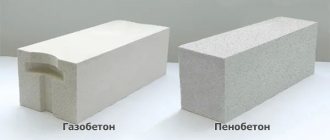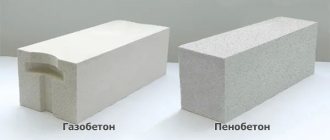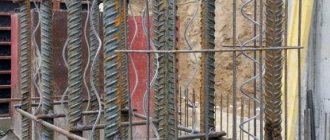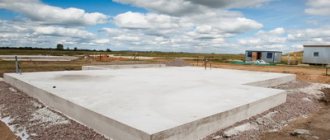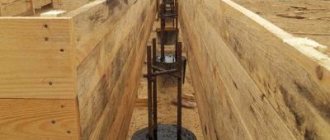The decision to install a basement in a private house should be balanced and thoughtful. On the one hand, it is convenient to place utility and technical rooms, a workshop or a billiard room in the basement. Often a garage for a car, a sauna, a bathhouse, and a gym are equipped under the house. On the other hand, careful calculations, considerable financial investments in the construction of underground premises, and reliable protection against leaks are required.
Foundation of a house with a basement Source lestnitsygid.ru
How to build a house with a basement correctly to avoid mistakes and alterations in the future?
Main types of basements
A basement under the house is an undoubted convenience. It increases the area that can be used for various needs. The ground floor houses:
- storerooms;
- cellar;
- Technical buildings;
- garage;
- sauna, bathhouse, swimming pool;
- Gym;
- workshop;
- billiard room;
- rest rooms.
Many specialized objects can be placed in the basement.
Depending on the purpose, a certain temperature and humidity regime must be maintained in the basement and ventilation must be provided.
For example, in a billiard room or workshop you need to provide heating, but in a cellar this is not at all necessary.
In a pantry, the ceiling can be at a height of 1.8 meters, while in a billiard room or recreation room the recommended value is at least 2.3-2.5 meters.
Access to the pantry or cellar is provided through a hatch or a narrow staircase with a door. Swing or overhead gates are installed in the garage.
The basement floor mark can be:
- below the base of the foundation;
- above her;
- on the same level.
In this video you will learn more about the foundation: Deepening an existing or new basement below the base of the foundation is not recommended unless an assessment of the condition of the structures, engineering surveys, and a preliminary calculation of the foundation for strength and stability have been carried out. Otherwise, this may lead to a decrease in the bearing capacity of the soil, uneven settlement and the appearance of cracks. Sometimes the consequences become catastrophic.
Important. Before building a foundation with a basement, you need to consider options for using the premises and draw up a plan for laying communications. This will help avoid cost overruns on remodeling and remodeling in the future.
Which concrete construction option is better?
When choosing how to build a basement from concrete blocks, you should first decide what the structure will be. The cellar can be monolithic or prefabricated. Each option has strengths and weaknesses.
Monolithic
Installation of a monolithic basement is more difficult than a prefabricated one. It is necessary to build formwork along the walls and fill it with concrete. This will result in a single cast structure.
The advantages of a monolithic concrete cellar are:
- Reliable: Less likely to leak water.
- High mechanical strength and durability.
- It is more convenient to make the entrance in the form of an arch.
- When creating, you can use gravel of different sizes and save the mixture.
- You can make a room of any size and place the door anywhere.
You can buy a monolith ready-made cellar made of reinforced concrete - it looks like a large “box”. To install it, you will need to dig a pit 20 cm wider, level the bottom and compact it. Then move the monolith inside and fill the holes with earth.
Made
Suitable for those who are new to construction or have little experience.
Before starting work, you need to dig a hole the size of the slabs, and cut a hole in one block for the entrance. Ready-to-use concrete blocks are placed on top of each other and connected using cement and special grooves. After installation, the surface is treated with a waterproofing agent.
Features of the foundation structure
The basement walls serve as the foundation for the entire house. They transfer the vertical load from the structure to the soil. In addition, the structure is subject to lateral pressure, which increases with depth.
To compensate for shear forces, it is recommended to widen the base of the foundation. All calculations are carried out according to the methodology described in SNiP 2.02.01-83, 2.09.03-8 “Manual for the design of buildings and structures”.
Ready-made projects are usually designed for specific soil conditions in the construction area. If the geological parameters differ, the calculated soil resistance is increased by a safety factor. Then the structures will have reserve strength.
The main characteristic that determines the depth of the foundation and the possibility of building a basement under the house is the height of the groundwater. It is installed during engineering and geological studies of the site. It is not recommended to bring the floor of basement rooms close to the boundary of underground moisture. The minimum distance from the groundwater level must be at least 0.5 meters.
Important. When the groundwater level is high, the feasibility of building a basement is highly questionable. No amount of waterproofing, even the highest quality and most modern, can save an underground structure from leaks. The real solution here is to install a coffered cellar.
The construction of a foundation for a house with a basement differs from the usual one in a number of features. To be done:
- more extensive excavation work;
- drainage device to remove soil moisture;
- more thorough waterproofing of surfaces;
- insulation of walls and floors;
- interior design of premises;
- installation of a ventilation system, if provided - heating.
The construction of this structure has a number of features.
For convenient access to the basement, a staircase with a door or hatch is installed. If a boiler, boiler or other complex equipment is located in the room, provisions are made for their safe operation and the possibility of repair.
The ground floor is covered with reinforced concrete slabs or wooden beams with a ceiling lining. You can install heated floors at the ceiling level.
Stairs to the cellar
Stairs to the cellar
A recessed cellar must be equipped with stairs that can be used to safely access the storage room. What are the stairs made of? You can make stairs from wood, metal or pour concrete. The choice remains with the cellar owner.
It is worth remembering that in damp rooms, wooden stairs will quickly rot, and metal ones will become covered with rust, so it is necessary to provide protection for structures from moisture (treat the material against corrosion and rot).
Types of basement foundations
When building houses, the most common structures are:
- tape;
- slab;
- pile
To arrange a foundation for a basement, the first two types are most often used, in which the structures immediately combine the functions of the foundation of the house and the walls of the room, and in slab ones - the floor of the basement.
You can dig a small basement or cellar in a house on a pile foundation. The main thing is to step back from the supports a certain distance so as not to weaken the thickness of the soil and protect the base from skewing and collapsing.
Strip foundations are made of monolithic concrete of a grade not lower than M200 or prefabricated elements - blocks, vertical panels, brick, stone.
Slabs are assembled from individual elements or poured on site. For working rods, reinforcement of class A400, A500 is used, for structural rods - A240.
Floor installation
The roof of the cellar can be prefabricated - made of slabs, beams, boards - or monolithic reinforced concrete. The wood is pre-treated to prevent rotting. When laying slabs, the joints are carefully filled with mortar or foam.
If the cellar is underground and free-standing, waterproofing from roll or coating materials is installed over the ceiling. Then thermal insulation with a thickness of at least 300 mm is installed - expanded clay, clay with sawdust, polystyrene foam, slag wool. The last layer is laid earth. A slight slope is provided for water drainage.
In above-ground or semi-buried structures, waterproofing and roofing materials are installed on the insulation layer. In the basement, located under the house, in a garage or shed, the roof is the floor of the superstructure.
Foundation construction technology
The construction of the foundation of a house includes preparatory, excavation, construction and finishing work, and laying communications.
Reliability of basement operation largely depends on high-quality excavation work, water disposal and drainage systems, hydro- and thermal insulation, and ventilation.
Excavation
The pit is dug manually or using an excavator. The lower mark should be at the level of the base, taking into account the sand and gravel backfill of 20-30 cm and the concrete slab or floor - 10-20 cm. To prevent surface water from filling the hole, work must be carried out as quickly as possible.
Drainage
Simultaneously with excavation work, drainage is arranged. Perforated pipes are laid around the perimeter of the house to collect soil water. They are looped and placed at an angle to the collector, from where the accumulated wastewater is pumped out or sent to the sewer.
A storm drain, a rain and melt water collection system laid along the blind area, will protect you from surface moisture.
Read more: installation of basement drainage.
Don't forget about drainage
Waterproofing
Prefabricated elements are mounted on the prepared base, masonry is made of bricks or blocks, or a monolithic foundation is arranged for a house with a basement. The surfaces of structures are insulated from moisture. Use any of the methods that are economically feasible in specific conditions to create a protective barrier:
- coating waterproofing;
- roll;
- welded;
- sprayed;
- penetrating;
- membrane;
- screen
All gaps and cracks must be carefully sealed to prevent possible leaks due to accidental runoff or rising groundwater.
Read more: waterproofing the basement from groundwater.
Thermal insulation
Insulation of external surfaces and floors is carried out with materials that do not rot and are not afraid of moisture. The most common are polystyrene foam or polystyrene foam; they have the necessary characteristics and are convenient to use. Thermal insulation boards are simply glued to the surface of the walls or placed under the screed.
A good heat-protective effect is obtained using:
- plasters with polystyrene foam or vermiculite;
- spraying polyurethane foam;
- thermal panels.
Important. Insulating the basement, plinth and blind area reduces energy losses for heating the house, reduces the forces of frost heaving, and extends the service life of structures.
Ventilation
Normal air exchange is one of the factors for maintaining an optimal microclimate in the basement. Without proper ventilation, condensation collects on the surfaces of walls and ceilings, provoking the development of mold. In addition, radon gas accumulates in buried rooms, which is harmful to human health.
To remove polluted air and bring in fresh air, install a natural, forced or combined ventilation system in the basement. To do this, exhaust ducts are laid, turbines or fans are installed.
The type of system and technical equipment are selected taking into account the required parameters and air volume. For small rooms, ventilation with natural circulation of air masses is sufficient; large areas require more powerful devices. They are equipped with purifiers, heaters or coolers to create the required microclimate.
Interior decoration
To decorate the basement, it is recommended to use materials that are not afraid of moisture. Wooden elements must be treated to prevent rotting.
Silicate moisture-resistant emulsions are chosen for painting. Slaked lime has proven itself well. It has high vapor permeability and bactericidal properties.
Don't forget about interior decoration
The walls are plastered with cement-sand mortar: it dries quickly and is not afraid of high humidity.
For interior decoration use:
- decorative brick;
- ceramic tiles;
- plastic panels;
- drywall;
- wooden vangon, planken.
With high-quality hydro-, thermal insulation and ventilation and low groundwater level, the risk of damage to expensive finishing materials is negligible.
How to find the groundwater level in your area
Water is the main enemy of all building structures, especially those located underground. To find out the groundwater level on the site, it is recommended to conduct small geological studies:
- Drill a hole 3 m deep. It is better to work in late autumn or spring. If the groundwater level is close, a wooden pole lowered into the well will be wet.
- Contact your local hydrogeological organization. There are all the answers regarding questions about UGV.
- Talk to your neighbors. Usually, nearby areas have similar conditions.
- Explore the area for the growth of moisture-loving plants - horse sorrel, sedge, nettle, alder, willow and others. If they are abundant on the site, groundwater is very close.
Nearby ditches, wells, and boreholes are also a source of information. Another telltale sign of a nearby aquifer is heavy dew falling at night. If, in addition to a high groundwater level, the soil has a clayey composition, building an underground cellar is very risky. It is better to focus on more “elevated” options.
Preparing for the construction of a foundation with a basement
Preparatory work is carried out at the construction site:
- Clear the area, remove trees and bushes in the construction area.
- The top layer of soil 30 cm thick is cut off for reclamation and transferred to composting.
- Move existing communications to a safe location.
- Pre-level the area.
- They mark out the plan of the house on the ground, break out the axes and install cast-offs.
- A drainage system is installed to protect against water entering the pit.
Transport of cargo and earth-moving equipment is organized to the construction site. Fence the site where excavation work is being carried out. Determine consumption and purchase materials. Store them in a convenient and accessible place.
Temporary power grids will be needed to illuminate the construction site. They provide shelters for workers - cabins, trailers, and bathrooms.
Wiring
Due to constant humidity, the cellar is classified as a high-risk area, so the electrical wiring is installed according to strict rules:
- sockets are located outside the basement in a dry room;
- cables are laid only openly in corrugated channels or boxes; metal pipes cannot be used;
- luminaires must be sealed to avoid condensation.
It is recommended that you consult a professional electrician before installing wiring.
Construction of a foundation for a basement: stages of work
Having the skill of a builder, you can build a foundation with your own hands for a house, cottage or garage with a basement. Step-by-step instructions will help with this.
Construction stages include:
- Marking the basement plan with pegs and cord according to the project or drawing. Mark the first point and measure the length of one of the sides with a tape measure. To find out the position of the remaining vertices, use a theodolite, a square or the Egyptian triangle rule.
- Displaying cast-offs. A board is fixed perpendicularly to two pegs or bars and driven into the ground at the corners in pairs - one on each of the intersecting sides. Fix the position of the axes with nails and tighten the cord.
- Digging a pit. Dig a hole for the foundation and basement, taking into account the thickness of the wall. The depth is equal to the design plus the height of the bedding and floor 30-50 cm.
- Construction of a crushed stone-sand cushion. Inert material is poured into the bottom of the pit in layers of 10 cm, compacted with a tamper, and the sand is spilled with water.
- Installation of formwork under a monolithic slab or tape. If the base is made of prefabricated elements, install foundation pads or FBS. In small basements, the walls are made of small blocks or bricks, not forgetting about reinforcement. Sleeves are installed in the places where communications pass.
- Reinforcing cages are placed in the formwork and filled with M200-M400 concrete. The mixture is compacted using vibrators or tampers.
After hardening, the panels are removed, water and thermal insulation work is carried out, and a drainage system is installed. Perform backfilling.
How to correctly calculate the composition of concrete
When constructing an underground room, the composition of the concrete mixture is important. It must be high quality and moisture resistant.
Usually the following composition is used: 1 part cement + 1 part sand + 3-4 parts gravel or crushed stone + water. All dry ingredients should be free of lumps; it is better to sift them through a fine sieve before mixing.
Note! For a more accurate calculation of the composition, special calculators are suitable. Many cement manufacturers have them and are focused on their own materials.
Useful tips
At first glance, building a cellar with your own hands is a simple matter. But every builder needs to remember:
- choose a location at a higher elevation, away from sources of pollution;
- The groundwater level must be at least 0.5 m below the floor;
- use materials that are resistant to moisture and decay, carry out protective treatment;
- foundation drainage, although not necessary, is very desirable, especially for regions with high precipitation rates or areas near water bodies;
- do not forget to reinforce the masonry;
- Observe electrical safety precautions when laying wiring.
Good insulation, reliable waterproofing and effective ventilation will help you preserve the harvest in the cellar without loss.


